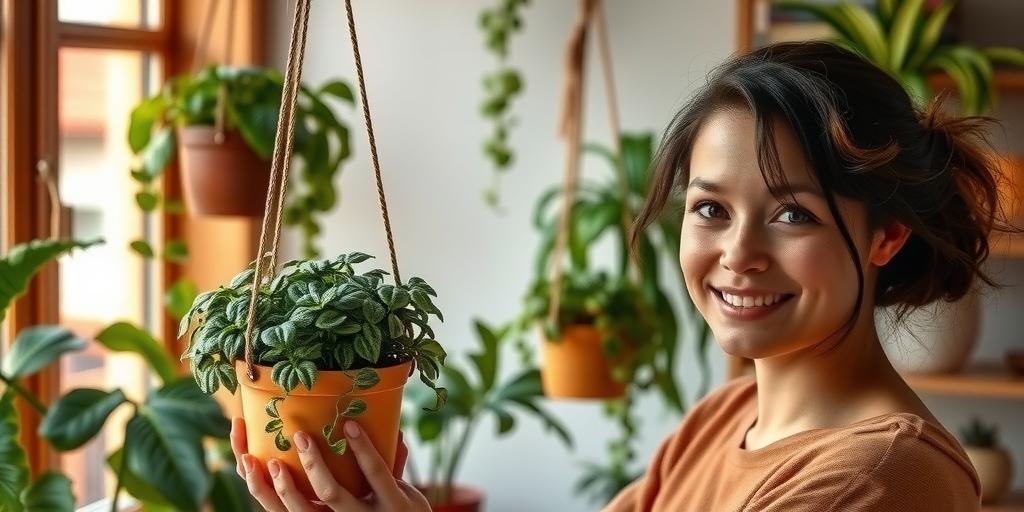
Essential Care Tips for Thriving Low Light Hanging Plants (2025 Guide)
Discover the best care tips for low light hanging plants to keep them lush and healthy! Learn about watering, placement, and ideal species for dim spaces.
Introduction
Did you know some of the most popular houseplants thrive in low light? If you’ve struggled to keep your hanging plants alive in dim corners, this guide is for you! Low light doesn’t mean no growth—with the right care, your plants can flourish even in shady spots. Whether you’re a beginner or a seasoned plant parent, these expert tips will help you create a thriving indoor jungle. Let’s dive in!
Best Low Light Hanging Plants for Your Home
Pothos (Devil’s Ivy)
If you’re new to houseplants, Pothos is your best friend. This hardy plant can survive in low light and even forgives the occasional missed watering. Its trailing vines look stunning in hanging baskets, and you can choose from different varieties like Golden Pothos (with yellow variegation) or Marble Queen (with white streaks).
Spider Plant
Spider plants are practically indestructible—perfect if you tend to forget about your green friends. They produce long, arching leaves and tiny “pups” (baby plantlets) that dangle from the mother plant. These can be propagated easily, so you’ll never run out of new plants!
Philodendron Heartleaf
With its fast-growing, heart-shaped leaves, the Heartleaf Philodendron is a great choice for adding lush greenery to dim corners. It thrives in low to medium light and can grow several feet long if given the space. Plus, it’s super forgiving if you forget to water it now and then.
Peperomia
Peperomias are compact, low-maintenance plants with thick, waxy leaves that retain water well. They come in many varieties, like the trailing Peperomia prostrata (String of Turtles) or the bushier Peperomia obtusifolia. Their small size makes them ideal for hanging planters in tight spaces.
String of Hearts
This delicate beauty features slender vines with heart-shaped leaves that cascade beautifully from a hanging pot. While it prefers bright, indirect light, it can tolerate lower light conditions—just expect slower growth. Let the soil dry out between waterings to keep it happy.
Ideal Placement for Low Light Hanging Plants
Avoid Direct Sunlight
Low light plants don’t need (or want) harsh sunlight. North-facing windows or shaded corners are perfect spots. If you only have east or west-facing windows, hang your plants a few feet away to avoid direct rays that could scorch the leaves.
Bright, Filtered Light Helps
While these plants survive in low light, they’ll thrive better with some bright, indirect light. Sheer curtains can help diffuse strong sunlight while still letting enough through for healthy growth.
Rotate for Even Growth
Plants tend to grow toward light sources, which can lead to lopsided growth. Give your hanging plants a quarter-turn every week or two to keep them looking full and balanced.
Hanging Planters Maximize Space
Elevating your plants with hanging baskets or macramé hangers not only saves floor space but also helps them catch whatever light is available. Plus, trailing vines look amazing when displayed at eye level or higher!
Watering Tips to Prevent Overwatering
Check Soil Moisture First
Before reaching for the watering can, stick your finger about an inch into the soil. If it feels dry, it’s time to water. If it’s still damp, wait a few more days. Overwatering is the #1 killer of houseplants, especially in low light where evaporation is slower.
Adjust Watering in Winter
Most plants grow slower in cooler months, meaning they need less water. Reduce your watering frequency in winter to prevent soggy soil and root rot.
Use Well-Draining Soil
A chunky, well-draining mix (like one with perlite or orchid bark) helps excess water escape quickly. Avoid dense, moisture-retentive soils that can suffocate roots.
Mist for Humidity
Many tropical plants (like Pothos and Philodendrons) appreciate a light misting now and then, especially in dry indoor air. Just don’t overdo it—wet leaves can invite fungal issues.
Fertilizing and Soil Requirements
Diluted Fertilizer Works Best
A balanced liquid fertilizer (like 10-10-10) diluted to half strength is ideal. Apply it once a month during spring and summer when plants are actively growing. Skip fertilizing in fall and winter.
Choose the Right Soil Mix
Peat-based or aerated mixes work well for most hanging plants. For succulents like String of Hearts, add extra perlite or sand for drainage.
Refresh Soil Occasionally
Over time, soil loses nutrients and can become compacted. Repot your plants every 1-2 years with fresh soil to keep them healthy and growing strong.
Common Problems and How to Fix Them
Yellow Leaves
Usually a sign of overwatering. Let the soil dry out more between waterings and trim off yellowed leaves. If the problem persists, check for root rot.
Leggy Growth
If your plant’s stems are long and sparse with few leaves, it’s likely stretching for more light. Move it to a slightly brighter spot (but still out of direct sun).
Pests
Spider mites, mealybugs, and aphids can sometimes appear. Wipe leaves with a damp cloth or treat with neem oil or insecticidal soap. Isolate affected plants to prevent spreading.
Slow Growth
If your plant seems stuck, reassess its light and nutrients. A weak fertilizer dose or a small move closer to indirect light might help.
Creative Display Ideas for Hanging Plants
Macramé Hangers
Add a boho vibe to your space with knotted macramé hangers. They’re perfect for showcasing trailing plants like Pothos or String of Hearts.
Wall-Mounted Shelves
Install floating shelves near windows and let your plants’ vines cascade downward. This works great for Spider Plants or Philodendrons.
Tiered Plant Stands
Group multiple hanging plants at different heights to create depth and visual interest. Mix textures—like pairing a Peperomia with a String of Hearts.
Glass Terrariums
For a modern look, place small trailing plants (like baby Spider Plant pups) in hanging glass terrariums. They’ll thrive in the humidity and make a stunning display.
Conclusion
Low light doesn’t have to limit your plant-growing dreams! With the right species, placement, and care, your hanging plants can thrive even in dim spaces. Remember to monitor watering, provide occasional nutrients, and adjust lighting as needed. Ready to transform your home into a green oasis? Start with a resilient pothos or spider plant and watch them flourish!
